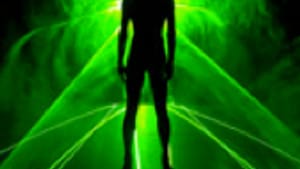Stay in the Loop
BSR publishes on a weekly schedule, with an email newsletter every Wednesday and Thursday morning. There’s no paywall, and subscribing is always free.
Humanity meets technology (successfully, for a change)
"Mortal Engine' by Chunky Move at Live Arts Festival

Over the past century— since Loie Fuller's first light and shadow dances— many choreographers have attempted to fuse the human body with film, light, video, shadow and even sound. (For an early example, see an 1896 film by Auguste and Louis Lumière— and don't you just love the serendipity of their name?).
I've personally watched attempts to marry dance and technology emerge for more than 15 years. Some works have been stillbirths, C-sections or outright late-term abortions. Rarely do they birth such a full integration between body and technology as the Australian choreographer Gideon Obarzanek's Mortal Engine achieved Thursday evening at the Wilma.
Mortal Engine provided many mesmerizing moments between the dancers and the shadowy video that swathed their bodies, either in solo or in combination with others. These shadows began by outlining the dancers' splayed limbs on the steeply raked stage like crime scene chalk in reverse. They shimmered like coal dust on the pale moon of the stage. Panels in the stage opened from time to time to create a vertical plane against which dancers moved as if they were graphite particles magnetized on a page.
The themes included mirror images, attraction and repulsion, and images that suggested a regression to the protozoan stage of life. In one duet, the woman dancer experiences a kind of electro infusion from which she cannot escape until her male counterpart covers her with his body and takes some of the infusion into himself, diffusing its power. In the most riveting scene, one dancer's shadow seems to crystallize and shatter into thousands of small fragments that cascade down the raked stage, draining the life out of her.
Connectivity, both organic and electric, was another motif, with dancers joined only by their forefingers, lit with a pinpoint spot that, as it diminished to darkness, suggested a disconnect.
The soundscape consisted of many noises we are accustomed to hearing in this age: the beeping of trucks driving in reverse, Velcro unripping. But it was the light, especially the neon green light that limned the dancers' bodies near the end that gave the Mortal Engine its otherworldly atmosphere.
That's not to say Mortal Engine didn't have its problems. Although its dancing was superb in its hard-edged, angular way, there was too little of it, and the laser show amounted to a lazy way to trick viewers into thinking they'd seen something spectacular.
That said, Mortal Engine illustrates what the Lord might have meant when he said, "Let there be light." Or not.♦
To read a response by Dan Rottenberg, click here.
I've personally watched attempts to marry dance and technology emerge for more than 15 years. Some works have been stillbirths, C-sections or outright late-term abortions. Rarely do they birth such a full integration between body and technology as the Australian choreographer Gideon Obarzanek's Mortal Engine achieved Thursday evening at the Wilma.
Mortal Engine provided many mesmerizing moments between the dancers and the shadowy video that swathed their bodies, either in solo or in combination with others. These shadows began by outlining the dancers' splayed limbs on the steeply raked stage like crime scene chalk in reverse. They shimmered like coal dust on the pale moon of the stage. Panels in the stage opened from time to time to create a vertical plane against which dancers moved as if they were graphite particles magnetized on a page.
The themes included mirror images, attraction and repulsion, and images that suggested a regression to the protozoan stage of life. In one duet, the woman dancer experiences a kind of electro infusion from which she cannot escape until her male counterpart covers her with his body and takes some of the infusion into himself, diffusing its power. In the most riveting scene, one dancer's shadow seems to crystallize and shatter into thousands of small fragments that cascade down the raked stage, draining the life out of her.
Connectivity, both organic and electric, was another motif, with dancers joined only by their forefingers, lit with a pinpoint spot that, as it diminished to darkness, suggested a disconnect.
The soundscape consisted of many noises we are accustomed to hearing in this age: the beeping of trucks driving in reverse, Velcro unripping. But it was the light, especially the neon green light that limned the dancers' bodies near the end that gave the Mortal Engine its otherworldly atmosphere.
That's not to say Mortal Engine didn't have its problems. Although its dancing was superb in its hard-edged, angular way, there was too little of it, and the laser show amounted to a lazy way to trick viewers into thinking they'd seen something spectacular.
That said, Mortal Engine illustrates what the Lord might have meant when he said, "Let there be light." Or not.♦
To read a response by Dan Rottenberg, click here.
What, When, Where
Mortal Engine. Performed by Chunky Move; choreography by Gideon Obarzanek. Live Arts Festival production through September 19, 2009 at Wilma Theater, 265 S. Broad St. (at Spruce). (215) 413-1318 or www.livearts-fringe.org/details.cfm?id=6845.
Sign up for our newsletter
All of the week's new articles, all in one place. Sign up for the free weekly BSR newsletters, and don't miss a conversation.

 Merilyn Jackson
Merilyn Jackson